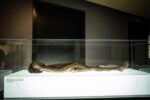Loredana Longo – Crash #2
 (1200x821).jpg)
In CRASHLoredana Longo sembra chiederci: quale è il confine, il limite, la gabbia? La risposta è solo una: il corpo.
Comunicato stampa
CRASH potrebbe sembrare un lavoro sulla pandemia, sulla costrizione domestica, sulla prigionia e la paura. Invece Loredana Longo aveva iniziato a concepire questa serie molto prima del lockdown e di tutto quello che ne è poi seguito in questi ultimi due anni. Risulta chiaro nei lavori in mostra che l’oppressione non è determinata dagli eventi o dalla limitazione alla mobilità. La libertà non si raggiunge uscendo di casa o distruggendo quello che ci blocca fisicamente nel movimento. La barriera, o il guardrail, non è un limite esterno. In questo senso la mostra CRASH segna un passaggio rispetto alla produzione precedente dell’artista in cui gli ostacoli da abbattere erano il muro (come in PIEDEDIPORCO, 2017), il mobilio borghese (come nella serie EXPLOSION iniziata nel 2006), le pareti della prigione (NOTHING AS IT SEEMS, 2009). In CRASHLoredana Longo sembra chiederci: quale è il confine, il limite, la gabbia? La risposta è solo una: il corpo.
Il corpo è il solo strumento di presa sul reale, il luogo attorno il quale misurare le cicatrici dell’esperienza. La pelle è guscio, involucro e contenitore: l’artista ne sonda i confini e le estensioni, immaginando un corpo-macchina sottoposto a una continua pulsione verso l’autodistruzione, la sfida, il superamento di ogni barriera. Come se solo attraverso il dolore potessimo sentirci vivi. Vi è in questo il ricordo dell’omonimo Crash di Ballard in cui si legge: «Per lui, ferite del genere erano le chiavi di una nuova sessualità, generata da una perversa tecnologia; e le loro immagini stavano appese nella sua galleria mentale come oggetti esposti in un museo da macello[1]». La cicatrice è il segno indelebile dello scontro e del dolore, ma non apre ad una nuova consapevolezza, o come dice l’artista: «L'esperienza non serve, sappiamo bene quali sono le cose che ci fanno male e le rifacciamo. Perché in fondo ci piace quell'errore, l'errore è la vita stessa». (leggi di più)
[1] James G.Ballard, Crash, Traduzione di Gianni Pilone Colombo, coll. Mistral, Rizzoli, 2000, p. 10.
un ringraziamento speciale a Planeta vini, Egoitaliano, imbottiti e arredamento, Stylnove ceramiche
en_
CRASH might seem to be a work about the pandemic, domestic constraint, imprisonment and fear. Instead, Loredana Longo had started to conceive this series long before the lockdown and everything that followed in the last two years. In the works on show it is clear that oppression is not determined by events or by the limitation of mobility. Freedom is not achieved by leaving the house or destroying what physically blocks our movement. The barrier, or the guardrail, is not an external limit. In this sense, the CRASH exhibition marks a shift from the artist's previous production in which the obstacles to be demolished were the wall (as in PIEDIPORCO, 2017), the bourgeois furniture (as in the EXPLOSION series begun in 2006), the prison walls (NOTHING AS IT SEEMS, 2009). In CRASH Loredana Longo seems to ask us: what is the border, the limit, the cage? The answer is only one: the body.
The body is the only instrument for grasping reality, the place around which the scars of experience are measured. The skin is a shell, a wrapping and a container: the artist probes its boundaries and extensions, imagining a body-machine subjected to a continuous drive towards self-destruction - the challenging and the overcoming of every barrier. As if only through pain we can feel alive. This is reminiscent of Ballard's Crash in which we read: «For him, such wounds were the keys to a new sexuality, generated by a perverse technology; and their images hung in his mental gallery-like exhibits in a slaughterhouse museum». The scar is the indelible sign of the clash and of the pain, but it does not generate a new awareness, or as the artist says: «Experience is of no use, we know what things hurt us and we do them again. Because after all, we like that mistake, the mistake is life itself[1]». (read more)
[1] James G.Ballard, Crash, Jonathan Cape, London, 1973.
a warmly thanks to Planeta vini, Egoitaliano, imbottiti e arredamento, Stylnove ceramiche



